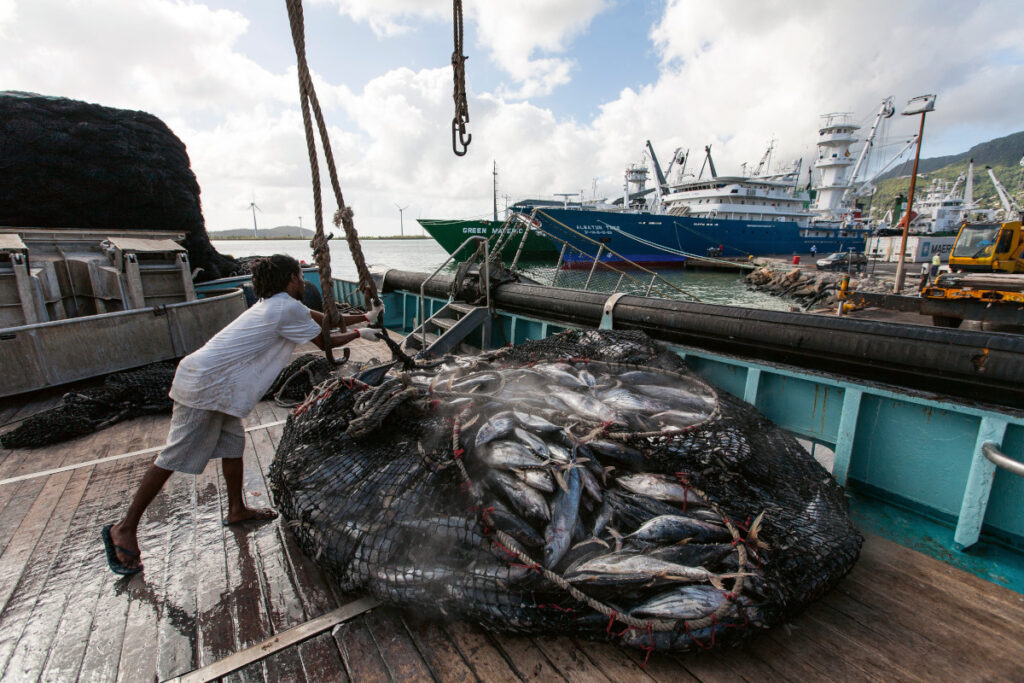[LUM#18] Towards sustainable fishing
How can we reconcile the exploitation and preservation of fishery resources? This is the main challenge facing the fishing industry today. To help address this issue, bioeconomists are bringing valuable tools to the table to tackle what is known as the "tragedy of the commons." Luc Doyen, a researcher at the Center for Environmental Economics in Montpellier, explains.

85 million tons. That is the amount of fish caught at sea in 2018, according to the Food and Agriculture Organization of the United Nations. This figure has remained stable for several decades, despite increasing fishing pressure. The reason for this is declining marine biodiversity. "35% of stocks are considered overexploited, meaning that the quantities of fish caught do not allow the population to renew itself," points out Luc Doyen, an economist at the CEE-M*.
How can we catch enough fish to feed a growing global population and sustain the industry, while preserving marine ecosystems and biodiversity? "One idea is to aim for maximum sustainable yield by harvesting the 'surplus' fish without affecting the viability of the resource, maintaining it at a steady state. But to do this, there are three dimensions—ecological, economic, and social—that are in tension and need to be reconciled, " says the CNRS researcher.
Fish War
Because at sea, fish generally belong to no one, and that is precisely what makes regulating fishing so complicated. "In economics, this is known as the tragedy of the commons: if fish stocks are a freely accessible common resource, then anyone can fish them. But once a fish has been caught by one fisherman, it is no longer available to other fishermen or for future reproduction of the resource." The result is a veritable fish war, where fishermen have every interest in catching as much as possible as quickly as possible, "and where those with the most resources catch the most."
To prevent this "fish war" from emptying the oceans, a policy regulating access to resources is essential. "Scientific public policy tools aimed at regulating fishing on a European scale first appeared in the 1950s, " explains the bioeconomy specialist. The CFP, the European Common Fisheries Policy, sets catch quotas based on scientific studies on the status of species and their reproduction. The quotas for all European waters are then allocated among countries and the various fishing organizations concerned.
But while coastal countries are responsible for managing fishing in their exclusive economic zones, which extend up to approximately 370 kilometers from the coast, beyond that point, i.e., on the high seas, freedom of fishing prevails. "In these unregulated areas, we can do whatever we want, and to avoid the damage caused by overfishing, we need a policy of coordination and cooperation between stakeholders at the supranational level."
Quota market
Because fishing involves a wide variety of stakeholders—fishermen, NGOs, consumers, tourists—who do not all see eye to eye. "Public policy is therefore a key lever for preserving resources, and the contribution of environmental economics is significant and even pioneering. The economy is not detached from reality; it provides concepts and evaluation methods for establishing recommendations and tools for implementing strategies and objectives." Several types of tools derived from economic research have thus been proposed to address this tragedy of the commons.
Regulatory instruments include , for example, fishing quotas and protected areas, which are designed to limit access to resources. These measures are supplemented by financial instruments, such as various taxes and subsidies, including taxes on fish landings and fuel.
"Another important tool concerns fishing quota markets," explains Luc Doyen. Each fisherman or fishing organization receives an initial quota for a given species based, for example, on their fishing history. But if one player wants to fish more than their initial quota and another is not going to use all of theirs, a transfer can be made via a market with a quota price, similar to the EU emissions trading system," explains the economist.
These fishing quota markets are widely used in New Zealand, but in Europe, a barter system currently prevails. Although this quota transferability system is far from being unanimously accepted by all stakeholders in the sector, "it does provide flexibility and thus improves coordination between stakeholders and the overall effectiveness of regulation, which is in line with more sustainable management of fishery resources," argues Luc Doyen.
Eco-labels
Other tools proposed by economists include eco-labels designed to guarantee consumers that the fish they buy has been caught responsibly, the best known of which is the MSC sustainable fishing label. "Such approaches enable us to move towards sustainable food systems by integrating producers, consumers, and marine resources, from fish to fork."
In a context where it is "not always easy to get ecologists and economists to talk to each other, " Luc Doyen points to the need for interdisciplinarity. "Environmental economics and the bioeconomy provide important insights, and the resource management tools proposed are bearing fruit in this sustainable approach to fisheries. The proof: since 2013, we have seen an overall improvement in European stocks. This is not the time for doom and gloom, but many challenges remain to be overcome in order to achieve a sustainable, resilient, and ecosystem-based approach to marine fisheries."
To Watch:
Luc Doyen's lecture on the theme "Does economics allow us to rethink ecology?" with Cap Sciences.
*CEE-M (UM, CNRS, INRAE, Institut Agro)
Find UM podcasts now available on your favorite platform (Spotify, Deezer, Apple Podcasts, Amazon Music, etc.).